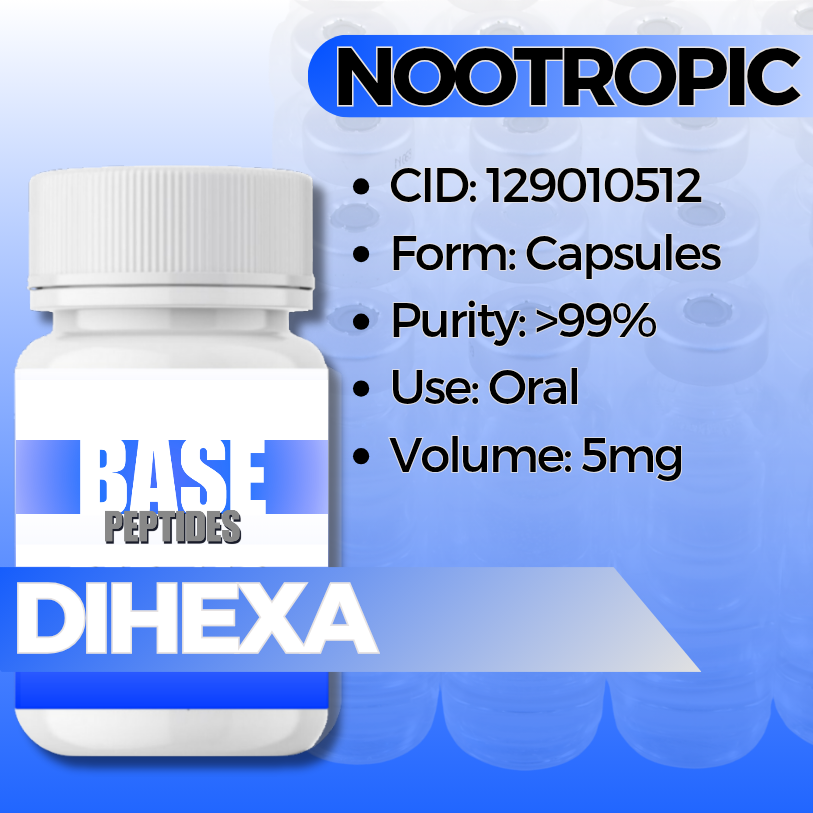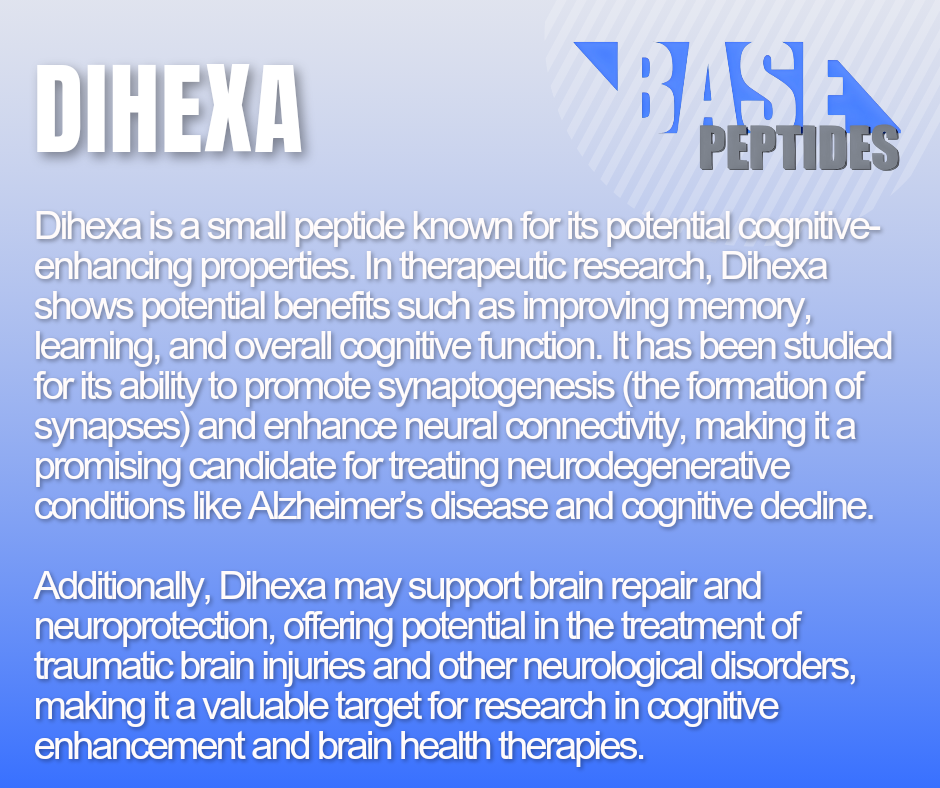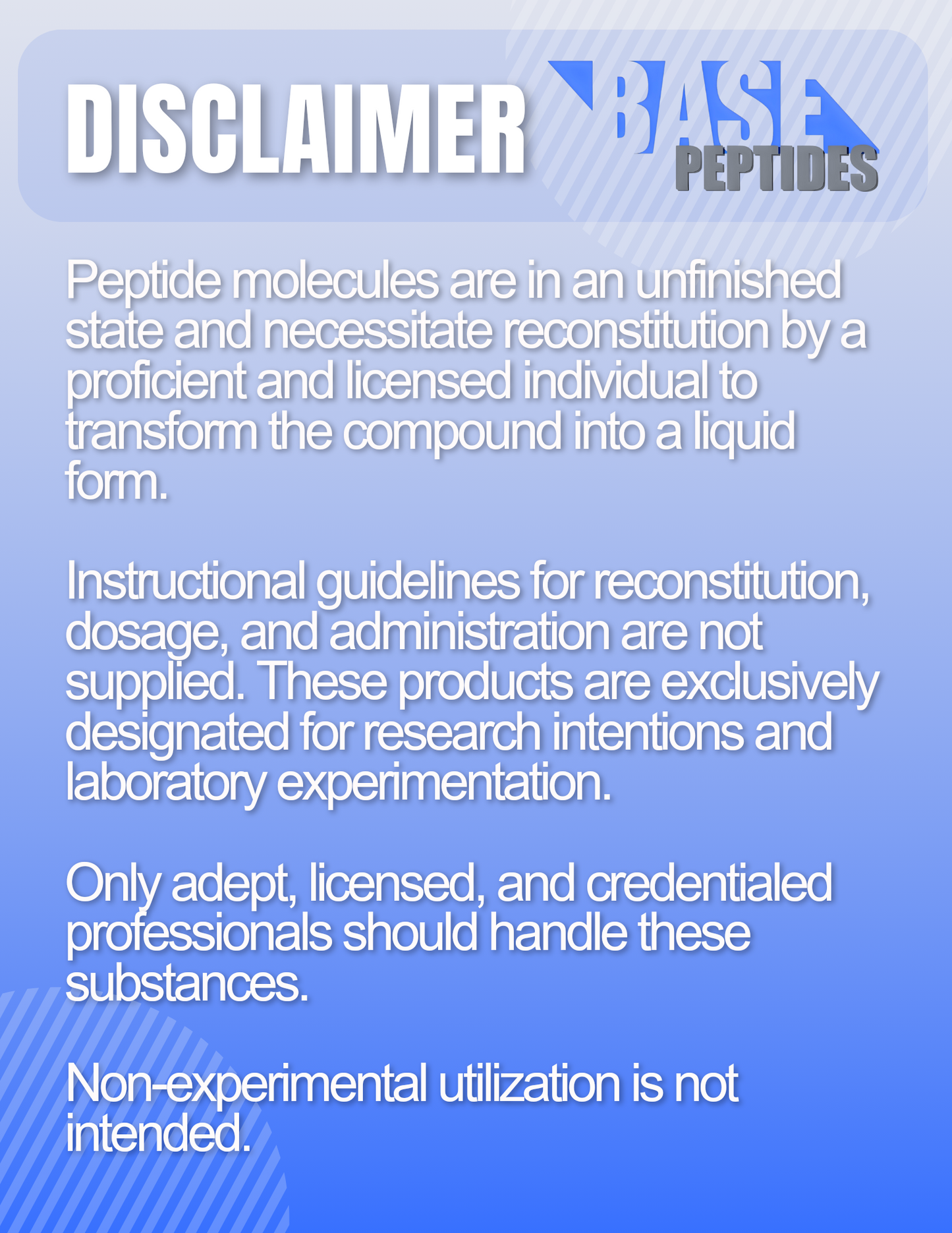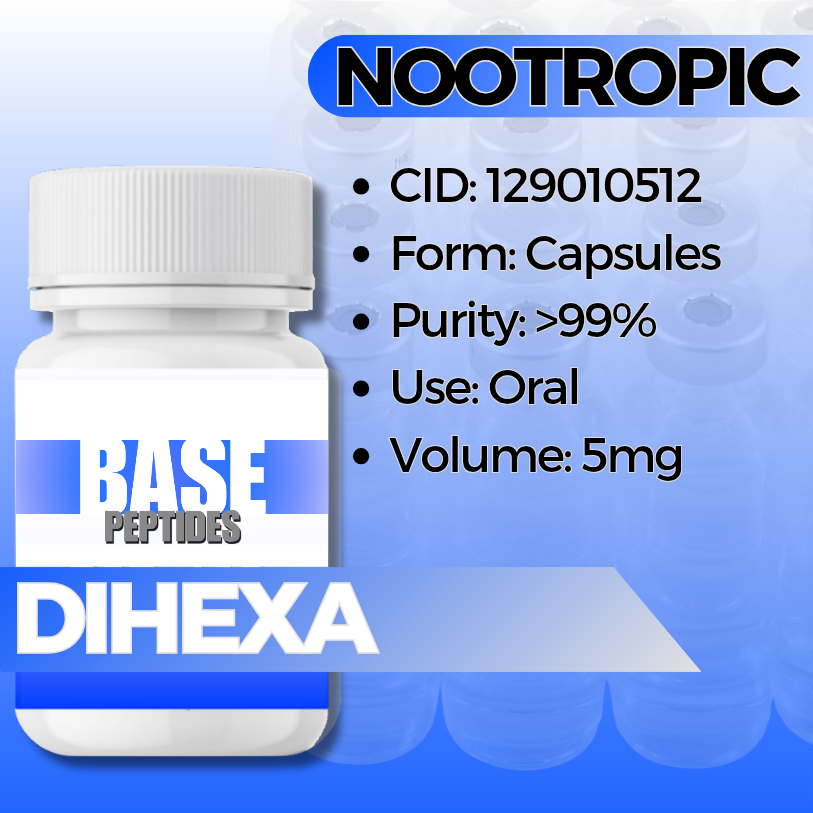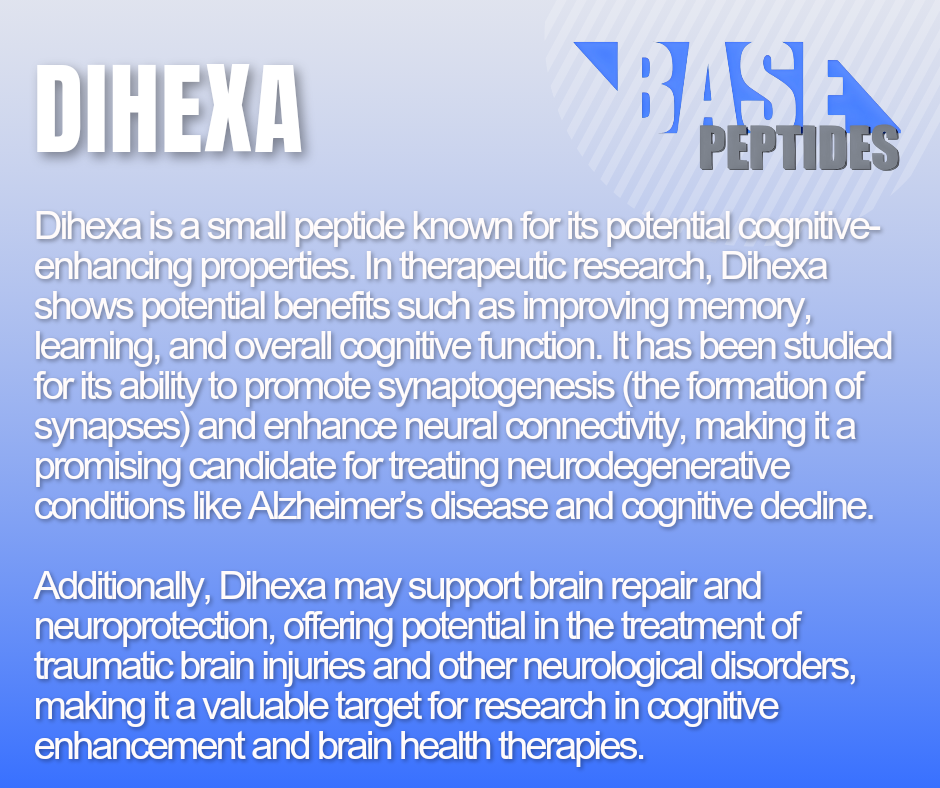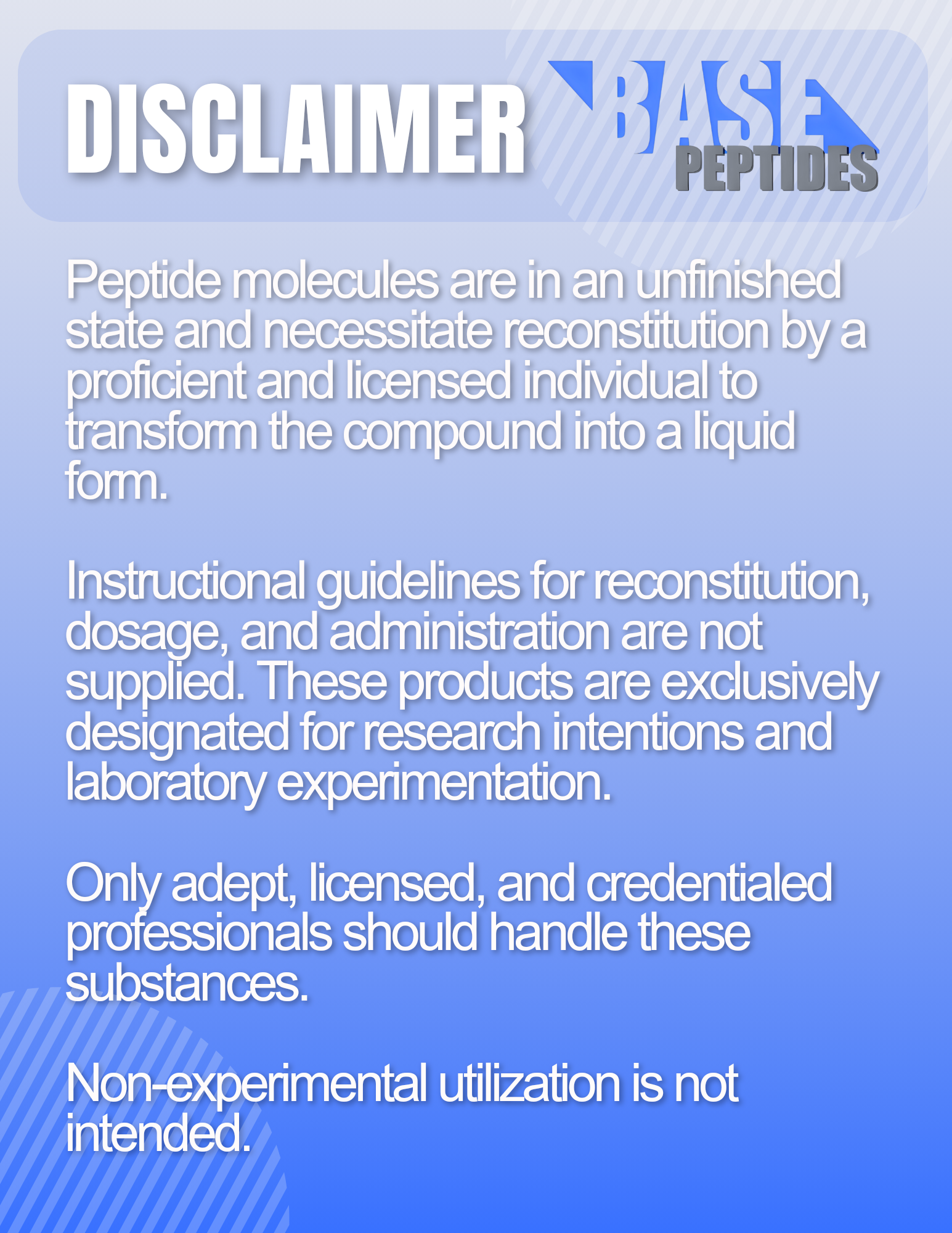Dihexa
Dihexa
Base Peptides are intended for licensed medical professionals and experienced researchers. Reconstitution required. Dosing and use instructions are not provided.
Couldn't load pickup availability
Dihexa — Brain-Repair & Synaptogenesis Peptide (Ang IV analog)
Dihexa (development code PNB‑0408) is a synthetic oligopeptide derived from Angiotensin IV (Ang IV) designed for high affinity binding to the hepatocyte growth factor (HGF) / c-Met receptor axis. It crosses the blood-brain barrier and in preclinical models has shown potent effects on synaptogenesis, neuron-survival and cognitive restoration. [oai_citation:0‡PMC](https://pmc.ncbi.nlm.nih.gov/articles/PMC8615599/?utm_source=chatgpt.com)
- Synonyms: Dihexa, PNB-0408
- CAS No.: 1401708-83-5 [oai_citation:1‡Wikipedia](https://en.wikipedia.org/wiki/Dihexa?utm_source=chatgpt.com)
- Formula / MW: C27H44N4O5 • ~504.7 g·mol⁻¹ [oai_citation:2‡Alzheimer's Drug Discovery Foundation](https://www.alzdiscovery.org/uploads/cognitive_vitality_media/Dihexa_1.pdf?utm_source=chatgpt.com)
- Primary target: HGF/c-Met receptor activation (neurotrophic signalling) [oai_citation:3‡ProSpec](https://www.prospecbio.com/dihexa?utm_source=chatgpt.com)
- Dihexa mimics HGF, binds to the c-Met receptor, and triggers downstream signalling that promotes **synapse formation**, **neuron survival** and **neural‐circuit repair**. [oai_citation:4‡PMC](https://pmc.ncbi.nlm.nih.gov/articles/PMC8615599/?utm_source=chatgpt.com)
- This means it may help convert “living but under-connected” neurons into more functional networks by increasing synaptic markers (e.g., synaptophysin) in preclinical studies. [oai_citation:5‡PMC](https://pmc.ncbi.nlm.nih.gov/articles/PMC8615599/?utm_source=chatgpt.com)
- Because it is blood-brain-barrier permeable, it is used in models of cognitive impairment, neurodegeneration and brain-injury research. [oai_citation:6‡Michael J. Fox Foundation](https://www.michaeljfox.org/grant/development-small-molecule-hepatocyte-growth-factor-mimetics-treatment-parkinsons-disease?utm_source=chatgpt.com)
- To examine **synaptogenesis**, neural-network repair, and cognitive restoration in rodent/neuro models.
- To study **neurodegenerative disease models** (e.g., Alzheimer’s, Parkinson’s) through a HGF/c-Met repair axis. [oai_citation:7‡Michael J. Fox Foundation](https://www.michaeljfox.org/grant/development-small-molecule-hepatocyte-growth-factor-mimetics-treatment-parkinsons-disease?utm_source=chatgpt.com)
- To explore **neuro-plasticity enhancement** protocols (learning/memory tasks, hippocampal connectivity). [oai_citation:8‡Creative Peptides](https://www.creative-peptides.com/resources/what-is-dihexa-peptide.html?utm_source=chatgpt.com)
Key Study Themes — What Was Tested, What Changed, Why It Matters
Synaptic & cognitive restoration in Alzheimer’s-models
- What was tested: In transgenic APP/PS1 mice and aged/chemically induced cognitive-impairment models, Dihexa administered and endpoints included synaptophysin expression, neuron counts, spatial memory. [oai_citation:9‡PMC](https://pmc.ncbi.nlm.nih.gov/articles/PMC8615599/?utm_source=chatgpt.com)
- What changed: Increased synaptophysin protein levels, increased neuronal counts in hippocampus, improved spatial memory/learning versus controls. [oai_citation:10‡PMC](https://pmc.ncbi.nlm.nih.gov/articles/PMC8615599/?utm_source=chatgpt.com)
- Why it matters: Suggests that not only protecting neurons but re-wiring synapses is feasible via HGF/c-Met activation in neurodegenerative contexts. [oai_citation:11‡Alzheimer's Drug Discovery Foundation](https://www.alzdiscovery.org/uploads/cognitive_vitality_media/Dihexa_1.pdf?utm_source=chatgpt.com)
Motor-neuron / Parkinson’s-Risk Models via HGF mimetic
- What was tested: Small-molecule HGF mimetic in Parkinson’s-style rodent models, looking at motor neuron survival and functional recovery. [oai_citation:12‡Michael J. Fox Foundation](https://www.michaeljfox.org/grant/development-small-molecule-hepatocyte-growth-factor-mimetics-treatment-parkinsons-disease?utm_source=chatgpt.com)
- What changed: Preliminary data suggest neuro-repair/axon-rescue in models of dopaminergic neuron damage. [oai_citation:13‡Michael J. Fox Foundation](https://www.michaeljfox.org/grant/development-small-molecule-hepatocyte-growth-factor-mimetics-treatment-parkinsons-disease?utm_source=chatgpt.com)
- Why it matters: Indicates a broader axis of repair beyond cognitive memory circuits (toward motor-neuron resilience).
Potential Research Applications
Neuro-degeneration & Aging
- Alzheimer’s, Parkinson’s, age-related synaptic decline, mild cognitive impairment.
Cognitive Enhancement / Brain Repair
- Learning/memory enhancement, hippocampal plasticity, post-concussion repair.
Neural Network Remodelling
- Synaptogenesis assays, dendritic spine density, neural stem-cell reactivation under HGF/c-Met signalling.
Synergistic / Comparator Peptides
Selank / Semax
- Why pair: These peptides modulate neuro-immune and neuro-trophic axes—pairing with Dihexa’s repair axis offers layered brain-repair protocols.
MOTS-c / SS-31
- Why pair: Mitochondrial support peptides combined with synaptic-repair peptides may offer enhanced neuro-resilience research designs.
Brain-Derived Neurotrophic Factor (BDNF) mimetics / HGF analogues
- Why compare: Dihexa is reported to be several orders of magnitude more potent than BDNF in synaptic assays. [oai_citation:14‡Wikipedia](https://en.wikipedia.org/wiki/Dihexa?utm_source=chatgpt.com)
Known Concerns (Context)
- Tumorigenic risk via c-Met activation: The HGF/c-Met pathway is a known oncogenic pathway—long-term safety data are lacking. [oai_citation:15‡Alzheimer's Drug Discovery Foundation](https://www.alzdiscovery.org/uploads/cognitive_vitality_media/Dihexa_1.pdf?utm_source=chatgpt.com)
- Human data extremely limited: No large, controlled human trials exist; most data are preclinical/in-vitro. [oai_citation:16‡Alzheimer's Drug Discovery Foundation](https://www.alzdiscovery.org/uploads/cognitive_vitality_media/Dihexa_1.pdf?utm_source=chatgpt.com)
- Mechanistic breadth: Because it drives growth/repair cascades, off-target effects and compensatory responses are possible—monitor broad endpoints in research models.
- General: For laboratory research use only; not for human consumption or therapeutic use.
Specifications & Handling
- Form: Lyophilized peptide powder (lot-coded) or solid (depending on supplier)
- Purity: Typically ≥98 % (HPLC/MS verified) in research-grade batches. [oai_citation:17‡Selleck Chemicals](https://www.selleckchem.com/products/dihexa.html?utm_source=chatgpt.com)
- Storage: ≤ −20 °C; protect from light/moisture; handle as per peptide-storage best practices.
- In solution: Reconstitute fresh; document vehicle, concentration, pH and time to assay.
- Labeling: Tamper-evident; “research use only”; traceable lot/SKU and expiration.
Regulatory & Use Notice
Sold for laboratory research use only. Not for human consumption, medical, or veterinary use. No human-use instructions are provided. Buyer is responsible for safe handling and regulatory and ethical compliance.
Dihexa Peptide Research | Synaptogenesis & Brain Repair | Neurodegeneration & Cognitive Enhancement Studies
